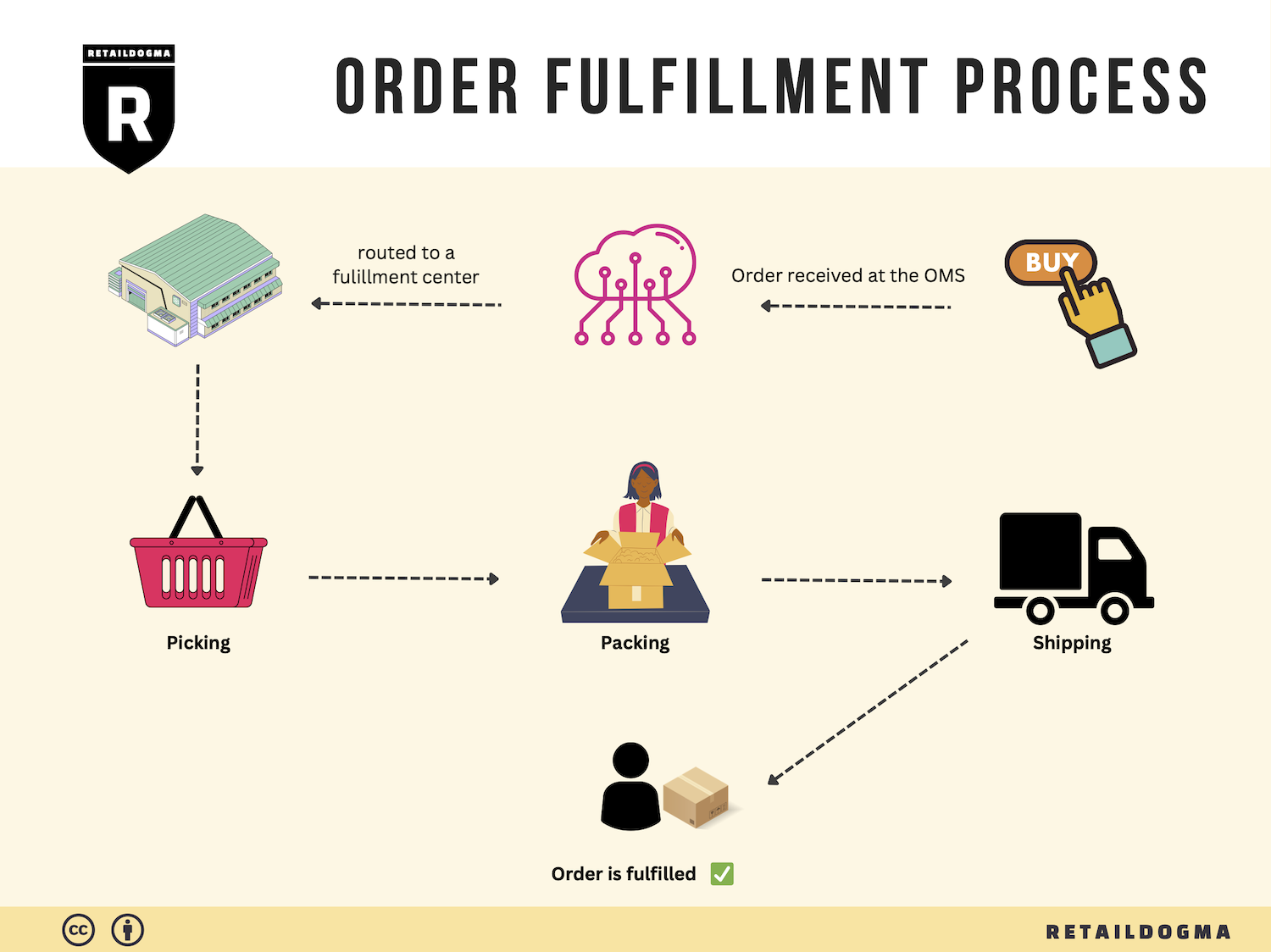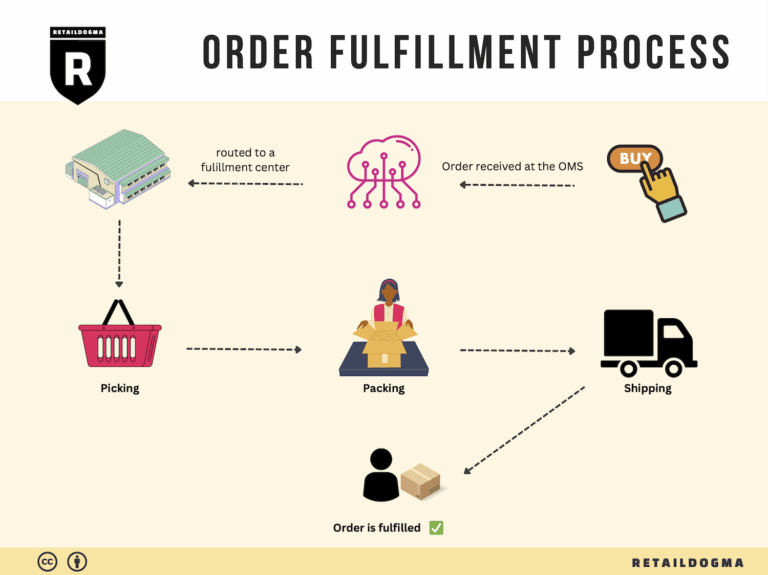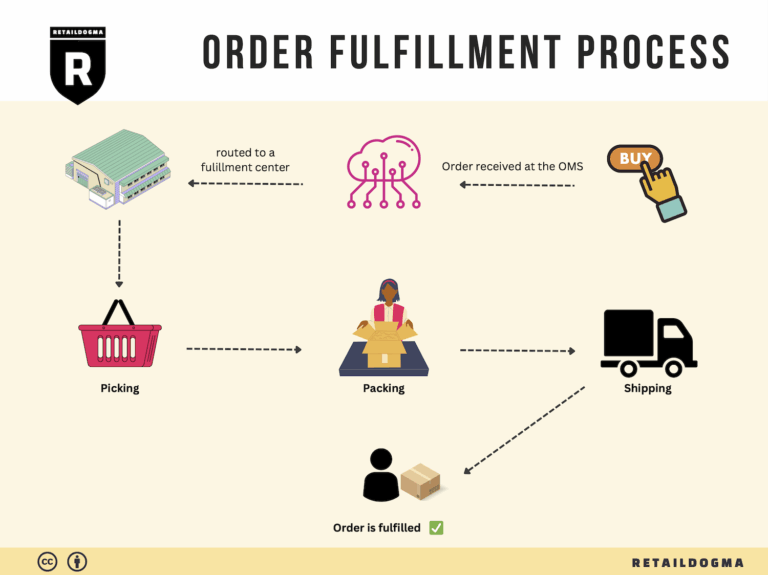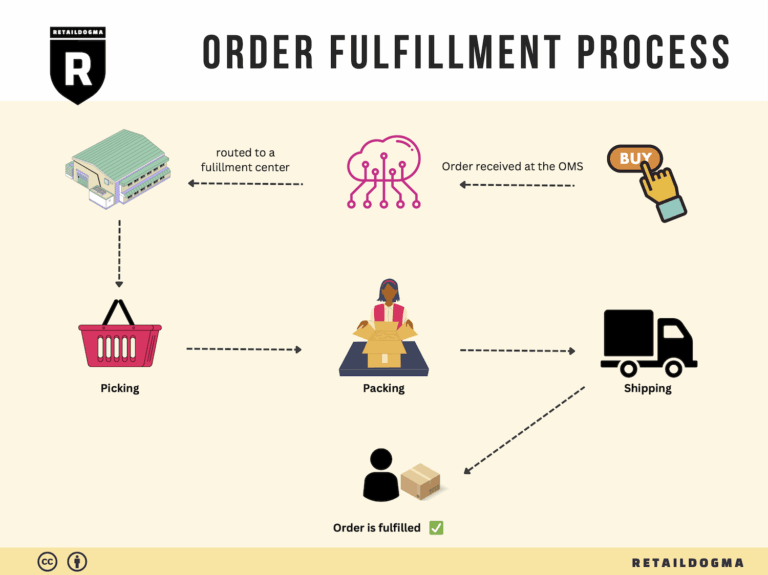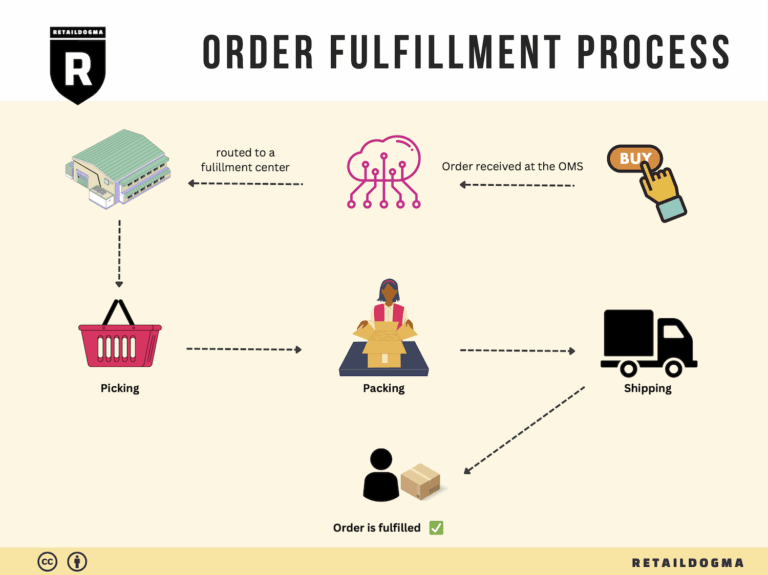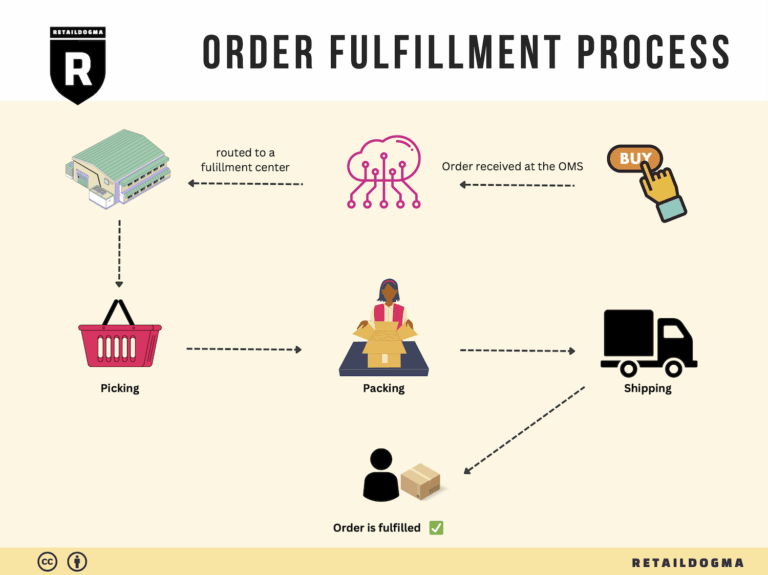What Is A Fulfillment Center? A Complete Guide (2025)
What is E-commerce Fulfillment? An Introduction for Growing Businesses
As your e-commerce business begins to scale, one of the most common challenges you may face is the overwhelming task of packing and shipping orders. Managing this aspect of your business can quickly become a logistical nightmare, diverting your focus from growth strategies and customer engagement. Understanding the fulfillment process is crucial to navigating these complexities efficiently.
What is E-commerce Fulfillment?
At its core, e-commerce fulfillment is the process of getting a product from your warehouse or supplier to your customer’s doorstep. This process encompasses several key stages, including inventory management, order processing, picking, packing, shipping, and handling returns. Each stage plays a vital role in ensuring that your customers receive their orders accurately and on time, which is crucial for maintaining customer satisfaction and loyalty.
What This Guide Will Cover
In this comprehensive guide, we will delve into various aspects of e-commerce fulfillment tailored for growing businesses. First, we will explore different fulfillment models, such as third-party logistics (3PL) and Fulfillment by Amazon (FBA), each offering unique advantages and challenges. Understanding these models will help you determine which approach aligns best with your business needs.
Next, we will outline the core services offered by fulfillment partners, including warehousing, inventory management, packing, shipping, and returns processing. Knowing what services are available will enable you to assess potential partners more effectively.
Choosing the right fulfillment partner is critical to your success. We will provide practical tips on evaluating potential partners based on factors such as scalability, technology integration, and industry expertise.
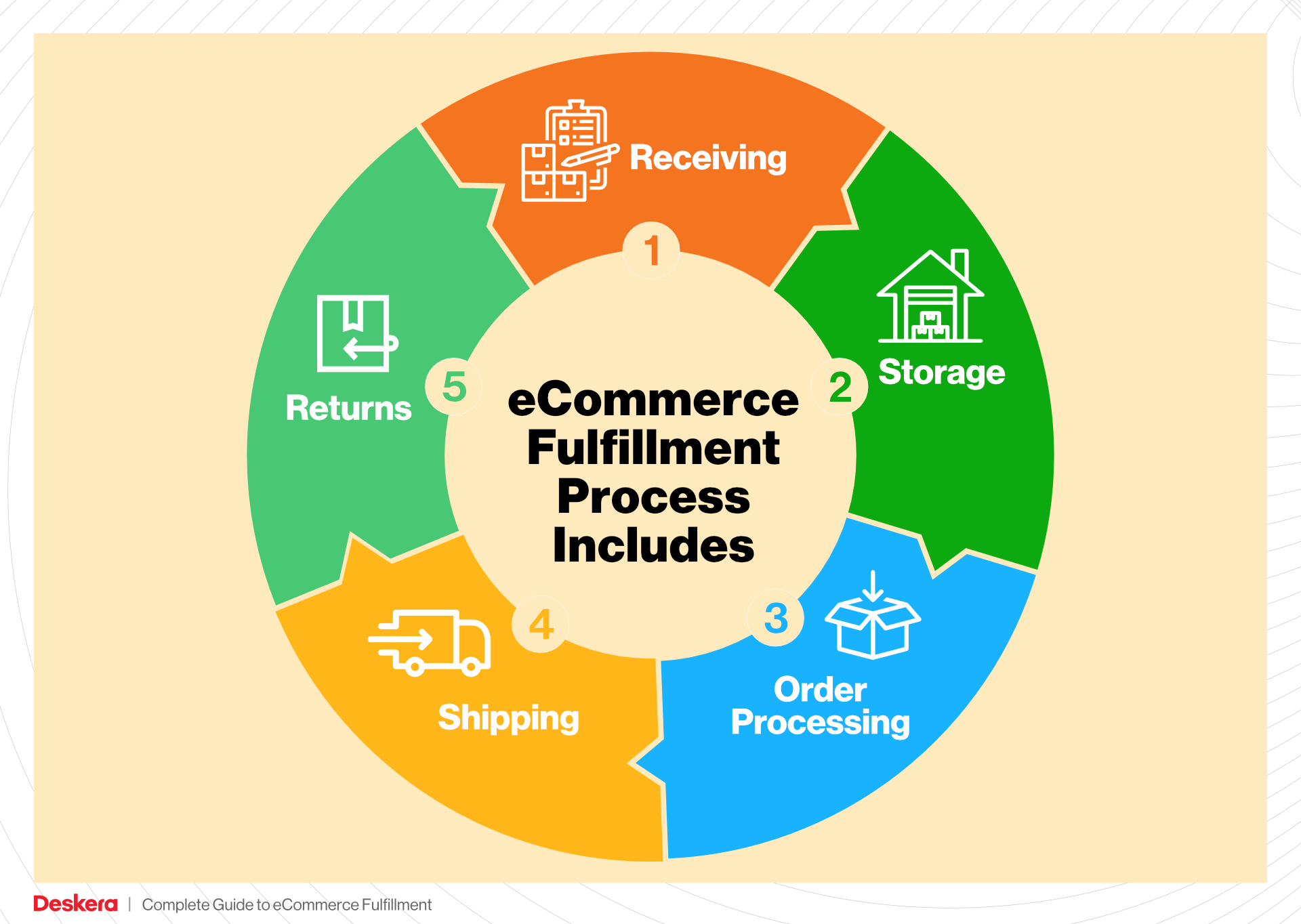
Lastly, we will discuss pricing structures associated with fulfillment services, helping you understand the cost implications and how to budget for these essential services.
Goal of This Guide
The ultimate goal of this guide is to empower you with the knowledge and insights necessary to make informed decisions about your logistics strategy. By understanding the nuances of e-commerce fulfillment, you can streamline your operations, enhance customer satisfaction, and position your business for sustainable growth. Whether you are just starting or are looking to optimize your existing fulfillment processes, this guide will serve as a valuable resource on your journey to scaling your e-commerce business.
What You’ll Learn In This Guide
- What is E-commerce Fulfillment? An Introduction for Growing Businesses
- The Order Fulfillment Process: From ‘Buy’ Button to Customer’s Door
- Comparing Fulfillment Models: In-House vs. 3PL vs. Dropshipping
- A Deep Dive into Amazon FBA: Pros, Cons, and Who It’s For
- Core Services Offered by Fulfillment Centers
- How to Choose a Fulfillment Partner: A 6-Point Checklist
- Understanding Fulfillment Pricing: A Breakdown of Common Fees
- Frequently Asked Questions (FAQs) about Fulfillment
- Conclusion: Is Outsourcing Fulfillment the Right Move for Your Business?
- Important Disclaimer
The Order Fulfillment Process: From ‘Buy’ Button to Customer’s Door
1. Receiving Inventory
The order fulfillment process begins with receiving inventory from suppliers or manufacturers. During this step, the logistics team inspects incoming shipments for quality, accuracy, and compliance with purchase orders. It’s crucial to ensure that the right quantity and type of products are received, as discrepancies can lead to inventory shortages or excesses that disrupt the fulfillment process.
A key term associated with this step is SKU (Stock Keeping Unit). Each product is assigned a unique SKU to streamline tracking and management. Proper SKU management allows businesses to monitor inventory levels accurately, making it easier to reorder stock before it runs low. Efficient receiving procedures also establish a foundation for the entire fulfillment process, ensuring that the subsequent steps operate smoothly.
2. Warehouse Storage
Once the inventory is received, it is stored in a designated warehouse. Effective warehouse storage strategies are vital for optimizing space and ensuring that products are easily accessible. This step involves organizing items based on various criteria such as product type, size, or sales velocity, which can significantly impact picking efficiency.
A critical concept in warehouse storage is slotting, which refers to the strategic placement of products within the warehouse. Proper slotting not only maximizes space utilization but also minimizes the time needed to retrieve items during order picking. By maintaining an organized storage system, businesses can reduce operational costs and improve order fulfillment speed, ultimately enhancing customer satisfaction.
3. Order Picking
Order picking is the process of retrieving items from storage in response to customer orders. This step is essential as it directly affects order accuracy and fulfillment speed. Warehouse staff utilize pick lists—documents that outline which items and quantities need to be collected for each order—to guide them in this process.
Efficiency in order picking can be improved through various methods, including batch picking (collecting items for multiple orders simultaneously) and zone picking (assigning specific warehouse areas to individual pickers). Implementing technology, such as barcode scanners or voice-picking systems, can further streamline this process, reducing errors and increasing productivity. The accuracy of order picking is critical, as mistakes can lead to returns, increased costs, and dissatisfied customers.

4. Order Packing
After items have been picked, they must be packed securely for shipping. This step involves assembling the items in appropriate packaging materials to prevent damage during transit. Effective packing not only protects products but also enhances the unboxing experience for customers, which can positively influence their perception of the brand.
A key consideration in this stage is dimensional weight pricing. Carriers often charge based on the size of the package rather than just its weight, so optimizing package dimensions can lead to significant cost savings in shipping. Additionally, businesses should aim for sustainability in their packaging choices, as eco-friendly practices are increasingly important to consumers. Proper packing ensures that orders arrive intact and on time, which is crucial for maintaining customer loyalty.
5. Shipping & Delivery
The final step in the order fulfillment process is shipping and delivery. This stage involves choosing the best shipping method based on cost, delivery speed, and destination. Companies must also manage relationships with carriers to negotiate favorable shipping rates and ensure reliable service.
A key term in this process is last-mile delivery, which refers to the final leg of the shipping journey from a distribution center to the customer’s doorstep. This stage is often the most complex and costly part of the shipping process, making it critical for businesses to optimize their last-mile strategies. Utilizing technology, such as route optimization software, can help reduce delivery times and costs. Effective shipping and delivery practices not only fulfill customer expectations but also contribute to a positive overall shopping experience, influencing future purchase decisions.
By understanding and optimizing each step of the order fulfillment process, e-commerce businesses can scale their operations efficiently, reduce costs, and enhance customer satisfaction, ultimately driving growth and success in a competitive marketplace.

Comparing Fulfillment Models: In-House vs. 3PL vs. Dropshipping
Fulfillment Models Comparison
| Model | Who Handles Inventory | Best For (Business Stage) | Key Advantage | Key Disadvantage |
|---|---|---|---|---|
| In-House Fulfillment | The business itself | Startups to established businesses | Complete control over operations | High overhead costs and resource demands |
| Third-Party Logistics (3PL) | A third-party provider | Growing businesses scaling rapidly | Access to expertise and scalability | Less control over logistics operations |
| Dropshipping | Supplier or manufacturer | New businesses with limited capital | Low upfront investment and risk | Lower profit margins and quality control issues |
In-House Fulfillment
In-house fulfillment involves managing all aspects of the logistics process within the business itself. This model is best suited for startups and established businesses that have the resources and infrastructure to handle their own warehousing, inventory management, and shipping. One of the primary advantages of in-house fulfillment is the complete control it offers over operations, allowing businesses to tailor processes to their specific needs and maintain a direct relationship with their customers. This can enhance brand loyalty and customer satisfaction as businesses can implement personalized services.
However, in-house fulfillment comes with significant challenges. The overhead costs can be substantial, requiring investment in warehouse space, staff, and technology. Additionally, as order volumes increase, the complexity of managing logistics can overwhelm internal resources, leading to inefficiencies and potential service issues. Businesses may also find it difficult to scale operations quickly in response to market demands, which can hinder growth.
Third-Party Logistics (3PL)
Third-party logistics (3PL) providers offer comprehensive logistics services, including warehousing, inventory management, order fulfillment, and shipping. This model is ideal for businesses that are experiencing rapid growth and need to scale their operations without the burden of managing logistics in-house. 3PL providers, such as Impact Fulfillment Services, bring expertise and resources that can significantly enhance supply chain efficiency. They typically have established relationships with shipping carriers, enabling businesses to benefit from discounted rates and faster delivery options.
The key advantage of partnering with a 3PL is the ability to scale quickly. As order volumes fluctuate, businesses can easily adjust their logistics needs without the need to invest in additional infrastructure or staff. However, there are drawbacks to consider. Utilizing a 3PL means relinquishing some control over logistics operations, which can lead to potential misalignment with business goals. Additionally, businesses must ensure that their chosen 3PL provider can meet their specific needs and maintain high service levels, as any shortcomings can directly affect customer satisfaction.
Dropshipping
Dropshipping is a fulfillment model where the retailer does not hold inventory but instead relies on suppliers or manufacturers to fulfill orders directly to customers. This model is particularly advantageous for new businesses with limited capital, as it requires minimal upfront investment. Entrepreneurs can start selling products online without the need to manage inventory, warehousing, or shipping logistics. This reduces financial risk and allows for greater flexibility in product offerings.
However, dropshipping also comes with significant challenges. The profit margins can be lower compared to other fulfillment models, as retailers often pay a premium for the convenience of not holding inventory. Additionally, quality control can be a major concern, as businesses have limited visibility into the suppliers’ processes and inventory levels. This can lead to issues with product quality, shipping times, and customer satisfaction, which can ultimately harm the brand’s reputation. Furthermore, reliance on suppliers can create complications in the fulfillment process, particularly if there are issues with stock availability or shipping delays.
Conclusion
Choosing the right fulfillment model is crucial for e-commerce businesses looking to scale efficiently. Each model—In-house fulfillment, 3PL, and dropshipping—has its unique advantages and disadvantages, making it essential for business owners to assess their specific needs, resources, and long-term goals. By understanding these models, entrepreneurs can make informed decisions that align with their operational capabilities and market demands, ultimately driving growth and enhancing customer satisfaction.
A Deep Dive into Amazon FBA: Pros, Cons, and Who It’s For
Understanding Fulfillment by Amazon (FBA)
Fulfillment by Amazon (FBA) is a service offered by Amazon that allows sellers to store their products in Amazon’s fulfillment centers. Amazon then takes care of storage, packaging, and shipping to customers. This service also includes customer service and returns handling. By leveraging Amazon’s vast logistics network and resources, sellers can focus on growing their business while Amazon handles the complexities of order fulfillment.
How FBA Works
-
Setting Up: Sellers create an Amazon seller account and enroll in FBA. They list their products on Amazon and prepare them for shipment to Amazon’s fulfillment centers.
-
Shipping Products: Sellers send their inventory to Amazon’s warehouses. Amazon provides guidelines on how to package and label products to ensure they are received correctly.
-
Storage and Inventory Management: Once the products arrive at the fulfillment center, Amazon stores them in their warehouses. Sellers can monitor their inventory levels through the Amazon Seller Central dashboard.
-
Order Fulfillment: When a customer places an order for a product, Amazon picks, packs, and ships the item directly to the customer. This process is streamlined, allowing for quick delivery times.
-
Customer Service and Returns: Amazon also handles customer service inquiries and returns for FBA orders, providing a seamless experience for customers.
Pros of Using FBA
-
Prime Eligibility: Products fulfilled through FBA are eligible for Amazon Prime, which attracts millions of loyal Prime members. This can significantly boost sales and visibility.
-
Customer Trust: Amazon is a trusted brand, and customers feel more comfortable purchasing products fulfilled by Amazon. This can lead to higher conversion rates for sellers.
-
Multi-Channel Fulfillment: FBA allows sellers to fulfill orders not only from Amazon but also from their own websites or other sales channels, providing flexibility and a unified inventory management system.
-
Scalability: FBA enables sellers to scale their business quickly without having to invest in warehousing or logistics infrastructure. Amazon’s established systems allow for rapid growth.
-
Time Savings: By outsourcing fulfillment, sellers can focus on marketing, product development, and other core business activities rather than logistics.
Cons of Using FBA
-
High Fees: FBA fees can be significant, including storage fees, fulfillment fees, and additional charges for long-term storage. This can eat into profit margins, especially for low-cost items.
-
Strict Inventory Rules: Amazon has stringent inventory management policies. Sellers must adhere to specific guidelines regarding product condition, packaging, and labeling. Non-compliance can lead to penalties or removal of inventory.
-
Commingling Risks: FBA products may be commingled with inventory from other sellers, which can pose risks for brand integrity. If a customer receives a damaged or counterfeit product, it can reflect poorly on the original seller.
-
Loss of Control: Sellers relinquish control over the fulfillment process, including packaging and shipping methods. This can lead to inconsistencies in branding and customer experience.
-
Dependency on Amazon: Relying on FBA means that sellers are subject to Amazon’s policies and changes. Any alterations in fees or service terms can significantly impact a seller’s business.
Who is FBA Best For?
Fulfillment by Amazon is ideal for a variety of sellers, particularly:
-
Small to Medium-Sized Businesses: Entrepreneurs and small businesses looking to expand their reach without the overhead of managing logistics can benefit greatly from FBA.
-
Brands with High Sales Volume: Sellers with high sales volume can leverage FBA to manage large order fulfillment efficiently while maintaining a high level of customer service.
-
Sellers of Consumer Goods: Products that are popular among Prime members, such as electronics, home goods, and seasonal items, are excellent candidates for FBA.
-
Multi-Channel Sellers: Businesses that sell through multiple channels and want a centralized solution for inventory management and order fulfillment will find FBA beneficial.
-
Sellers Seeking Growth: Those who want to take advantage of Amazon’s vast marketplace and logistics network to scale their business quickly will find FBA an attractive option.
Conclusion
Fulfillment by Amazon offers a powerful solution for e-commerce sellers looking to streamline their operations and tap into Amazon’s extensive customer base. While the service comes with its own set of challenges, including high fees and inventory management requirements, the benefits of increased visibility, customer trust, and scalability often outweigh the drawbacks. Ultimately, FBA is best suited for sellers who are prepared to navigate its complexities and leverage its strengths to grow their e-commerce businesses effectively.
Core Services Offered by Fulfillment Centers
Inventory Management & Warehousing
Inventory management and warehousing are foundational services offered by fulfillment centers, ensuring that products are stored safely and efficiently until they are needed for shipment. A robust inventory management system enables e-commerce businesses to maintain optimal stock levels, track product movement, and forecast demand accurately.
The benefit of effective inventory management is twofold: it minimizes holding costs while maximizing product availability. When businesses can accurately gauge inventory levels, they can avoid overstocking, which ties up valuable capital, and stockouts, which can lead to lost sales and dissatisfied customers. Fulfillment centers utilize advanced technology, such as barcode scanning and inventory management software, to provide real-time visibility into stock levels, allowing businesses to make informed decisions about restocking and product launches.
Furthermore, the strategic location of fulfillment centers enhances shipping efficiency. By storing products closer to key markets, businesses can reduce shipping times and costs, ultimately improving customer satisfaction and loyalty. This geographical advantage is particularly critical for e-commerce businesses aiming to compete with giants like Amazon, where fast delivery is a customer expectation.
Pick and Pack Services
Pick and pack services are integral to the order fulfillment process, allowing e-commerce businesses to streamline their shipping operations. This service involves selecting (picking) the right products from the warehouse and packing them securely for shipment. Fulfillment centers employ trained staff and efficient systems to ensure that orders are filled accurately and quickly.
The primary benefit of pick and pack services is the enhancement of operational efficiency. By outsourcing this process to a fulfillment center, businesses can focus on their core competencies—such as marketing and product development—while leaving the logistics to experts. This not only saves time but also minimizes the risk of errors, which can lead to costly returns and customer dissatisfaction.
Moreover, fulfillment centers often utilize automated systems to improve the speed and accuracy of picking and packing. With the integration of technology like robotics and warehouse management systems, these centers can increase throughput and reduce labor costs. This technological edge allows e-commerce businesses to scale operations more effectively as order volumes grow, ensuring that they can meet customer demand without compromising service quality.
Kitting and Assembly
Kitting and assembly services offered by fulfillment centers allow e-commerce businesses to bundle products together into a single package or assemble components into a finished product before shipping. This service is particularly beneficial for businesses that offer promotional items, gift sets, or complex products requiring assembly.
The primary advantage of kitting and assembly is the ability to enhance product presentation and create a better customer experience. Bundled products can be marketed as value sets, encouraging larger purchases and increasing average order value. Additionally, pre-assembled products save customers time and effort, leading to higher satisfaction rates.
By leveraging kitting and assembly services, businesses can also streamline their supply chain processes. Instead of managing multiple SKUs in inventory, companies can consolidate items into kits, reducing the complexity of inventory management. This simplification not only lowers carrying costs but also improves order accuracy, as fulfillment centers can handle the kitting process with precision and care.
Furthermore, kitting services can be tailored to seasonal promotions or specific marketing campaigns, allowing businesses to respond quickly to market demands. This flexibility enables e-commerce brands to stay competitive and relevant, driving sales while maintaining operational efficiency.
Returns Management (Reverse Logistics)
Returns management, or reverse logistics, is a critical service provided by fulfillment centers that helps e-commerce businesses efficiently handle product returns. This process includes receiving returned items, inspecting their condition, restocking them if possible, and managing the logistics of returning products to the inventory or the manufacturer.
The importance of effective returns management cannot be overstated. A seamless return process enhances customer satisfaction and builds trust, which is crucial for repeat business. Fulfillment centers often implement user-friendly return policies and easy-to-navigate online return portals, making the experience hassle-free for customers.
Moreover, efficient returns management can significantly reduce operational costs. By centralizing the returns process within a fulfillment center, businesses can streamline handling and inspection, ensuring that returned products are processed quickly and accurately. This can lead to quicker restocking and minimized losses from unsellable items.
In addition, data from returns can provide valuable insights into customer behavior and product performance. By analyzing return trends, businesses can identify issues with specific products, address quality concerns, and improve overall product offerings. This proactive approach not only enhances customer satisfaction but also drives continuous improvement in product development and inventory management.
In conclusion, the core services offered by fulfillment centers are designed to optimize the supply chain for e-commerce businesses. From inventory management and warehousing to pick and pack services, kitting and assembly, and returns management, these services provide essential support that enables businesses to scale operations, enhance customer satisfaction, and maintain a competitive edge in the marketplace.
How to Choose a Fulfillment Partner: A 6-Point Checklist
Location & Warehouse Network
When selecting a fulfillment partner, the geographic location of their warehouses is crucial. A well-distributed network can significantly impact shipping times and costs, enhancing customer satisfaction.
Why It Matters:
– Shipping Speed: Proximity to your customer base can reduce delivery times, which is vital for customer satisfaction in e-commerce.
– Cost Efficiency: Strategic locations can lower shipping costs, particularly for businesses with high order volumes.
Questions to Ask:
– Where are your fulfillment centers located, and how do they align with my target market?
– Can you provide insights on shipping times and costs based on these locations?
– Do you have plans for expanding your network in the future?
Technology & Integrations
In today’s fast-paced e-commerce environment, the technology used by your fulfillment partner can make or break your operations. Seamless integration with your existing systems is essential for efficient order management.
Why It Matters:
– Real-Time Tracking: Advanced technology allows you to track inventory levels and orders in real-time, improving transparency and operational efficiency.
– Automation: Automation reduces manual errors and speeds up order processing.
Questions to Ask:
– What order management systems do you integrate with?
– Can your technology provide real-time inventory updates and tracking?
– How do you handle system outages or technical issues?
Specializations (e.g., Cold Storage, Oversized Items)
Different businesses have unique needs based on the products they sell. Understanding a 3PL’s specializations can help you determine if they are the right fit for your specific requirements.
Why It Matters:
– Product Handling: If you sell temperature-sensitive items or oversized products, specialized facilities and expertise are necessary to maintain quality and compliance.
– Regulatory Compliance: Certain industries, like food and pharmaceuticals, have stringent regulations that require specific handling and storage capabilities.
Questions to Ask:
– What types of products do you specialize in handling?
– Do you have specialized facilities for cold storage or oversized items?
– How do you ensure compliance with industry regulations?
Scalability & Capacity
As your business grows, your fulfillment needs will evolve. Choosing a partner that can scale with you is essential to avoid disruptions in your supply chain.
Why It Matters:
– Future-Proofing: A scalable partner can accommodate growth without requiring you to switch providers, saving time and resources.
– Flexibility: Seasonal fluctuations in demand require a partner who can easily adjust to changing order volumes.
Questions to Ask:
– What is your current capacity, and how do you handle peak seasons?
– Can you accommodate sudden increases in order volume, and how do you manage that?
– What are your plans for expanding capacity in the future?
Pricing and Contracts
Understanding the pricing structure and contract terms is crucial to avoid unexpected costs and ensure a good return on investment.
Why It Matters:
– Budgeting: Transparent pricing helps you budget effectively and plan for future expenses.
– Flexibility: Short-term contracts or no long-term commitments can provide the flexibility needed as your business grows.
Questions to Ask:
– What is your pricing model (e.g., per order, storage fees, shipping costs)?
– Are there any hidden fees I should be aware of?
– Do you require long-term contracts, or can we work on a month-to-month basis?
Customer Support & Reviews
Reliable customer support can make a significant difference in your fulfillment experience. Additionally, researching reviews and testimonials can provide insights into the partner’s reputation and reliability.
Why It Matters:
– Responsive Support: Issues may arise, and having a responsive support team can minimize disruptions.
– Reputation: Customer reviews can provide an unbiased perspective on the partner’s performance and reliability.
Questions to Ask:
– What customer support channels do you offer (e.g., phone, email, chat)?
– What is your average response time for support inquiries?
– Can you provide references or testimonials from current clients?
Conclusion
Choosing the right fulfillment partner is a critical decision that can significantly impact your e-commerce operations. By carefully evaluating potential partners based on location, technology, specialization, scalability, pricing, and customer support, you can make an informed choice that aligns with your business goals. Take the time to ask the right questions and ensure that your fulfillment partner is equipped to support your growth and meet your unique needs.
Understanding Fulfillment Pricing: A Breakdown of Common Fees
Initial Setup Fees
Initial setup fees are often incurred when onboarding with a fulfillment service provider. These fees cover the administrative costs associated with establishing your account, integrating your e-commerce platform, and setting up the necessary technology to manage your inventory and orders. The amount can vary significantly based on the complexity of your operations and the specific services required.
Typically, these fees may range from a few hundred to several thousand dollars. It’s essential to clarify what these fees include—such as system integration, training, and account management—to avoid unexpected costs later on. Some fulfillment providers may offer promotions that waive these fees, so it’s wise to inquire about potential discounts.
Receiving Fees
Receiving fees are charged for the process of accepting and logging inventory into the fulfillment center. This includes inspecting incoming products, updating inventory systems, and storing items in the warehouse.
These fees are usually calculated per pallet or per hour, depending on the provider’s pricing structure. For instance, if you send multiple pallets of goods, you may be charged a flat rate for each pallet received. Alternatively, some providers charge based on the time spent handling your shipment. It’s crucial to understand the receiving process and how it impacts your overall logistics costs, particularly if you anticipate frequent shipments.
Storage Fees (per pallet/bin)
Storage fees are charged for the space your products occupy within the fulfillment center. This fee is typically calculated on a monthly basis and can vary based on the type of storage used—whether it’s bulk storage, bin storage, or temperature-controlled environments for sensitive items.
Providers often charge storage fees on a per-pallet or per-bin basis. For example, if you store ten pallets of goods, you would be charged a set fee for each pallet per month. Additionally, some fulfillment centers may implement tiered pricing, where the cost per pallet decreases as the volume of stored goods increases. To optimize storage costs, it’s beneficial to regularly assess your inventory levels and adjust your storage needs accordingly.
Pick & Pack Fees (per item/order)
Pick and pack fees are incurred when the fulfillment center picks items from inventory to fulfill an order and then packs them for shipping. This process is critical in ensuring that the correct items are sent out to customers.
The fees are generally calculated on a per-item or per-order basis. For example, a fulfillment service might charge a fixed fee for each item picked, plus an additional fee for packing. If an order contains multiple items, this can quickly add up. Understanding how these fees are structured can help you make informed decisions about your product offerings and order fulfillment strategies. Consider negotiating bulk order pricing if you have high sales volumes to help lower costs.
Shipping Fees
Shipping fees are one of the most significant costs associated with fulfillment services, as they cover the expense of transporting your products from the fulfillment center to your customers. These fees can vary based on several factors, including the shipping method (standard, expedited, international), the weight and dimensions of the package, and the distance to the destination.
Many fulfillment providers partner with major carriers to offer discounted shipping rates, which can help reduce overall costs. Shipping fees may be charged per package or based on weight tiers. It’s advisable to review your shipping options and consider the implications on delivery times and costs, as these factors can significantly impact customer satisfaction.
Tips for Getting an Accurate Quote
-
Provide Detailed Information: When requesting a quote, offer as much detail as possible about your products, order volume, and fulfillment needs. This information allows providers to give you a more accurate estimate.
-
Understand the Fee Structure: Ask for a clear breakdown of all potential fees involved in the fulfillment process. This includes not just the obvious charges but also any ancillary fees that could arise during the lifecycle of your inventory.
-
Negotiate Terms: Don’t hesitate to negotiate with fulfillment service providers. Many are willing to adjust pricing, especially if you can commit to a certain volume of orders.
-
Request Custom Quotes: If your business has unique needs, request a custom quote tailored to your specific requirements. Providers may offer discounts for high volumes or long-term contracts.
-
Evaluate Multiple Providers: Compare quotes from several fulfillment centers to ensure you are getting the best value for your needs. This also gives you leverage in negotiations.
By understanding these common fees and how they are calculated, you can better manage your logistics costs and make informed decisions that support your e-commerce growth.
Frequently Asked Questions (FAQs) about Fulfillment
1. What is a fulfillment service?
A fulfillment service is a third-party logistics (3PL) provider that manages the storage, packing, and shipping of products on behalf of e-commerce businesses. These services streamline the logistics process, allowing businesses to focus on sales and marketing while ensuring efficient order processing and delivery to customers.
2. What is the difference between a warehouse and a fulfillment center?
A warehouse primarily serves as a storage space for goods, focusing on inventory management. In contrast, a fulfillment center is designed to handle the entire order processing workflow, including picking, packing, and shipping products directly to customers. Fulfillment centers are equipped with technology and processes to expedite order fulfillment and improve customer satisfaction.
3. How much do fulfillment services cost?
The cost of fulfillment services can vary widely based on factors such as order volume, type of products, storage requirements, and specific services needed. Typically, fulfillment providers charge for storage space, picking and packing services, and shipping fees. Many offer transparent pricing structures with no hidden fees, allowing you to receive custom quotes based on your business needs.
4. What types of products does Impact Fulfillment Services specialize in?
Impact Fulfillment Services specializes in handling consumer packaged goods (CPG), including both food and non-food products. They offer tailored solutions for product launches, club store promotions, and retail distribution, ensuring that products are packaged and delivered efficiently to meet market demands.
5. What geographic areas do Impact Fulfillment Services cover?
Impact Fulfillment Services has fulfillment centers strategically located across the United States and Canada, including key locations in states like North Carolina, Texas, and California, as well as Ontario, Canada. This extensive geographic coverage allows for optimized shipping times and cost-effective fulfillment solutions across North America.
6. How does Impact Fulfillment Services ensure quality and compliance?
Impact Fulfillment Services adheres to current Good Manufacturing Practices (cGMP) and holds FDA registration, ensuring that their operations meet rigorous quality standards and regulatory requirements. This commitment to quality control helps protect your brand and ensures that products are delivered safely to consumers.
7. What technology does Impact Fulfillment Services use for order management?
Impact Fulfillment Services employs advanced technology and software systems that integrate seamlessly with major e-commerce platforms. This allows businesses to track orders, manage inventory levels, and access real-time shipping information, enhancing operational efficiency and customer satisfaction.
8. What value-added services are offered beyond standard fulfillment?
In addition to basic warehousing and shipping, Impact Fulfillment Services provides a range of value-added services such as custom packaging design, material sourcing, retail distribution, and comprehensive order fulfillment. These services are designed to optimize your supply chain and meet specific customer requirements.
9. How does Impact Fulfillment Services differentiate itself from competitors?
Impact Fulfillment Services stands out by offering a full suite of 3PL and contract packaging solutions tailored to the unique needs of branded consumer product companies. Their expertise in assembly, custom packaging, and compliance, combined with the stability and resources provided by their affiliation with Ryder System, ensures reliable and effective logistics support.
10. How can I get started with Impact Fulfillment Services?
To begin utilizing Impact Fulfillment Services, you can request a custom quote through their website. They will assess your specific needs, including order volume and product specifications, and provide a tailored solution to help you scale your e-commerce operations efficiently.
Conclusion: Is Outsourcing Fulfillment the Right Move for Your Business?
Evaluating the Benefits of Outsourcing Fulfillment
Outsourcing fulfillment can be a transformative decision for e-commerce businesses looking to streamline operations and enhance customer satisfaction. One of the most significant advantages is the time savings it provides. By entrusting logistics to a specialized partner, you can focus on core business functions such as product development, marketing, and customer engagement. This shift allows for a more strategic allocation of resources, ultimately driving growth.
Scalability is another crucial benefit. As your business grows, so do your logistical demands. A reliable fulfillment service can easily adjust to fluctuations in order volume, ensuring that you can meet customer expectations without the burden of managing increased inventory or staffing challenges. This flexibility is essential in today’s fast-paced market, where responsiveness can be the difference between retaining a customer and losing them to a competitor.
Moreover, partnering with an experienced fulfillment provider grants access to industry expertise and advanced technology. These partners often come equipped with cutting-edge systems for inventory management, order tracking, and shipping logistics, all of which can enhance your operational efficiency and improve customer experience.
However, not all fulfillment services are created equal. Choosing the right partner is vital to your business’s long-term success. Look for a provider that aligns with your specific needs, offers transparent pricing, and has a proven track record in your industry. Conduct thorough research and due diligence before making a commitment.
Take Action
To determine if outsourcing fulfillment is the right move for your business, start by auditing your current shipping process. Assess your operational pain points, evaluate your capacity for growth, and consider how a fulfillment partner could help you achieve your objectives. This strategic reflection can guide you in making an informed decision that supports your business’s growth trajectory.
Important Disclaimer
⚠️ Important Disclaimer
The information in this guide is for educational purposes. Fulfillment services, pricing, and platform features change frequently. Always conduct your own due diligence and consult with providers directly before making business decisions.
